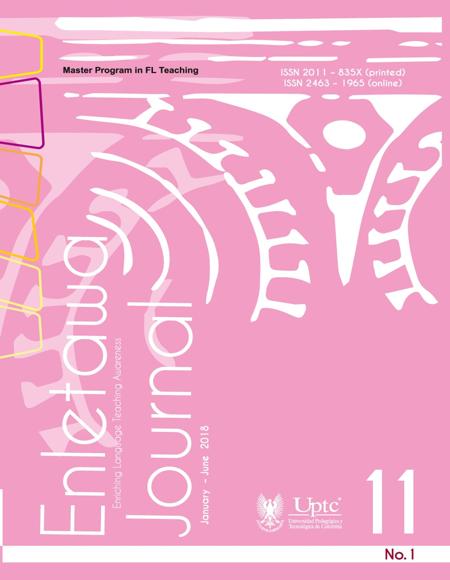An ICT Tool in a Rural School: A Drawback for Language Students at School?

Abstract
Technology involves a vast number of advantageous usages that range from the sciences to the educational settings. Limited access to computers and the internet, among other factors, are a drawback, thus, creating a digital gap. Nonetheless, the panorama for English as a Foreign Language (EFL) and the use of internet communication technologies (ICT) in Colombia is promising given the countless number of new resources found online. However, using ICT tools requires not only the teacher’s attention, but also governmental aid before they can be implemented in the EFL class. The scope of the ICT tools in the rural setting is vast and has a great impact on students. Therefore, if factors, such as equipment in decent conditions, updated applications, and training, are not provided the real amplitude of these tools cannot be measured.
Keywords
Rural Education, EFL teaching, ICT drawback, ICT Policy for EFL
References
Barley, Z. A., and Brigham, N. (2008). Preparing teachers to teach in rural schools (Issues & Answers Report, REL 2008–No. 045). Washington, DC: U.S. Department of Education, Institute of Education Sciences, National Center for Education Evaluation and Regional Assistance, Regional Educational Laboratory Central. Retrieved from http://ies.ed.gov /ncee/edlabs.
Batardière, M., and Jeanneau, C. (2015). Facilitating a face-to-face tandem language exchange on a university campus. Studies in Self-Access Learning Journal, 6(3), 288-299.
Bonilla, S.X., and Cruz-Arcila, F. (2014). Critical socio-cultural elements of the intercultural endeavour of English teaching in Colombian rural areas. Profile Issues in Teachers Professional Development, 16(2), 117-133.
Bonilla Carvajal, C. A., and TejadaSánchez, I. (2016). Unanswered questions in Colombia’s foreign language education policy. Profile Issues in Teachers’ Professional Development, 18(1), 185-201.
Celebic, G., and Rendulic, D. I. (2011). IT desk. Info–project of computer e-education with open access. Retrieved from http://www. itdesk.info/handbook_basic_ict_ concepts.pdf
Christensson, P. (2010, August 26). TechTerms. ICT Definition. Retrieved from https:// techterms.com/definition/ict
Colombia ya cuenta con 500 zonas wifi gratis (2017, June 4). El Tiempo. Retrieved from http://www. eltiempo.com/colombia/otrasciudades/colombia-llega-hoy-a500-zonas-wifi-gratis-95276
Computadores para educar (2017). ¿Qué es Computadores para Educar? Retrieved from http://www. computadoresparaeducar. gov.co/es/nosotros/que-escomputadores-para- educar
Congreso De La República De Colombia. (2009). Ley Nº 1341 de 30 de julio de 2009. Retrieved from http://www.mintic.gov.co/ portal/604/w3-article-3707.html
Datexco Company S.A. (2015). Estudio, uso y apropiación de las TIC en Colombia. Retrieved from https://www.mintic.gov.co/ portal/604/articles-15296_ recurso_3.pdf
Decreto Ley 0019, (2012). Retrieved from http://www.secretariasenado. gov.co/senado/basedoc/ decreto_0019_2012.html
Departamento Nacional de Planeación (1999). Documento Conpes 3063, Consejo Nacional De Política Económica y Social. Programa de donación masiva de computadores a colegios públicos “Computadores para Educar”. Retrieved from http://www. computadoresparaeducar.gov. co/sites/default/files/inlinefiles/Conpes_3063.pdf
Departamento Nacional de Planeación. (2013). Documento Conpes 3769 Consejo Nacional de Política Económica y Social. Declaratoria de Importancia Estratégica de los Proyectos “Ampliación Programa de Telecomunicaciones Sociales” E “Implementación 800 Tecnocentros Nacional”. Retrieved from https://www.notinet. com.co/descargar_archivo. php?idinv=262770
Garrett, N. (2009). Computer assisted language learning trends and issues revisited: Integrating innovation. The Modern Language Journal, 93, 719-740.
Garrison, D. R., and Kanuka, H. (2004). Blended learning: Uncovering its transformative potential in higher education. The Internet and Higher Education, 7, 95-105.
Hirotani, M. (2009). Synchronous versus asynchronous CMC and transfer to Japanese oral performance. CALICO Journal, 26(2), 413-438.
Karpati, A. (2011). Digital literacy in education. UNESCO Institute for Information Technologies in Education. Retrieved from http://iite. unesco. org/ publications/3214688.
Lankshear, C., and Knobel, M., (2011) New literacies: everyday practices and social learning, 3rd edition. Open University Press, Maidenhead, UK.
Mafuraga, M., and Moremi, M. (2017). Integrating Information and Communication Technology in nglish Language teaching: A case study of selected Junior Secondary Schools in Botswana. International Journal of Education and Development Using Information and Communication Technology, 13(1), 142-152.
Marshall, D. (2001). What is multimedia? Retrieved from https://users. cs.cf.ac.uk/Dave.Marshall/ Multimedia/node10.html
Mercado, B. (2017). Análisis: ¿cómo superar la crisis de educación en el campo colombiano? Revista Semana. Retrieved from https://www.semana.com/ nacion/articulo/panoramade-la-educacion-en-el-campocolombiano/531885
Miangah, T. M., and Nezarat, A. (2012). Mobile-assisted language learning. International Journal of Distributed and Parallel Systems, 3(1), 309.
Ministerio de Educación Nacional (MEN). (2009). MAESTROS competentes. Al tablero. Retrieved from https://www. mineducacion.gov.co/1621/ article-195576.html
Ministerio de Educación Nacional (MEN). (2002). Decreto 3020. Retrieved from https://www. mineducacion.gov.co/1621/ articles-104848_archivo_pdf
Ministerio de Educación Nacional (MEN). (2001). Más campo para la educación rural. Al tablero. Retrieved from https://www. mineducacion.gov.co/1621/ article-87159.html
Ministerio de las Tecnologías y la Información (MinTIC). (2018). Ecosistema digital: infraestructura. Retrieved from http://www.mintic.gov.co/ portal/vivedigital/612/w3propertyvalue-630.html
Ministerio de las Tecnologías y la Información (MinTIC). (2018). Kioskos vive digital. In Colombia tic portal de estadísticas del sector. Retrieved from http://
109 colombiatic.mintic.gov.co/679/ w3-propertyvalue-36365.html
Ministerio de las Tecnologías y la Información (MinTIC). (2015). Vive Digital Colombia 2014-2018. Retrieved from https://www. mintic.gov.co/portal/604/ articles-5193_recurso_2.pdf
Palermo, E., and Cox, L. (2014). Who invented the internet? Livescience. Retrieved from https://www. livescience.com/42604-whoinvented-the-internet.html
Padilla, J., Vega, P., and Rincón, D. (2014). Tendencias y dificultades para el uso de las TIC en educación superior. Entramado, 10(1), 272-295.
Perfetti, M. (2004). Estudio sobre la educación para la población rural en Colombia. Retrieved from http:// red-ler.org/informes.htm
Ramos-Holguín, B., and AguirreMorales, J. (2016). English Language Teaching in rural areas: A new challenge for English Language Teachers in Colombia. Cuadernos de Lingüística Hispánica, (27), 209-222.
Scarino, A., and Liddicoat, A. (2009). Teaching and learning languages: A guide. Melbourne: Curriculum Corporation.
Servon, L. (2002). Bridging the digital divide: Technology, community and public policy. Blackwell publishing.
Tinio, V. (2003). ICT in Education. Retrieved from https://akgul. bilkent.edu.tr/egitim/eprimer- edu.pdf
Torut, B. (2000). Computer-assisted language learning: An overview. Silpakorn University International Journal, 1(1), 131-153.
Tri, D., and Nguyen, N. (2014). An exploratory study of ICT use in English language learning among EFL university students. Teaching English with Technology, 14(4), 32-46.
Trucano, M. (n. d.) Technology and Innovation in Education. Retrieved from https://www.worldbank. org/en/topic/edutech
Universia (2012, April 4). Docentes serán capacitados en TICs. Retrieved from http://noticias. universia.net.co/ciencia-nn-tt/ noticia/2012/04/04/921677/ docentes-seran-capacitados-tics. html
Uribe, A., and Machett, L. (2010). Information literacy in Colombia: Report of the state of the art. Retrieved from https://www.ifla. org/files/assets/informationliteracy/publications/il-report/ colombia-2010-en.pdf